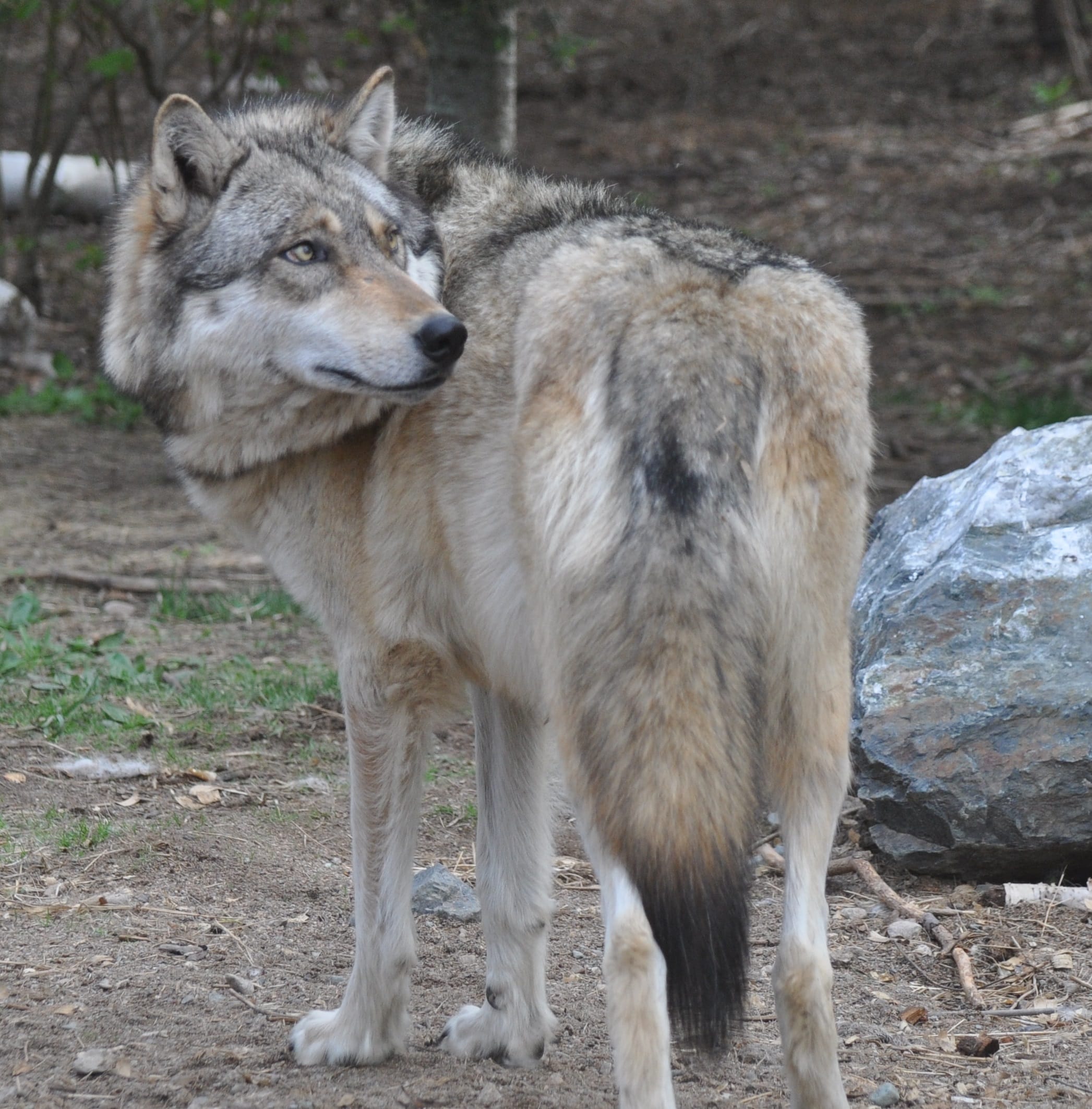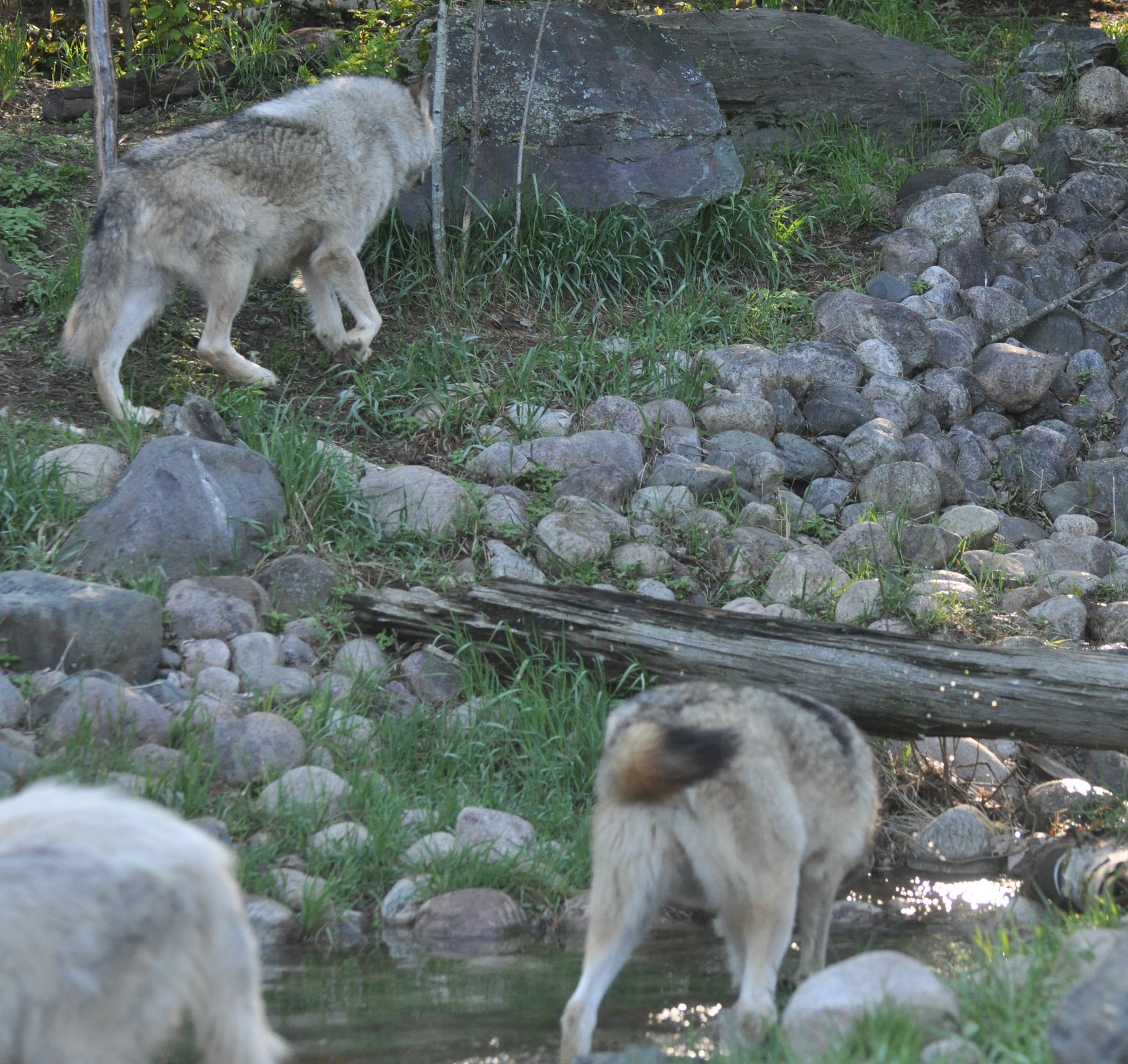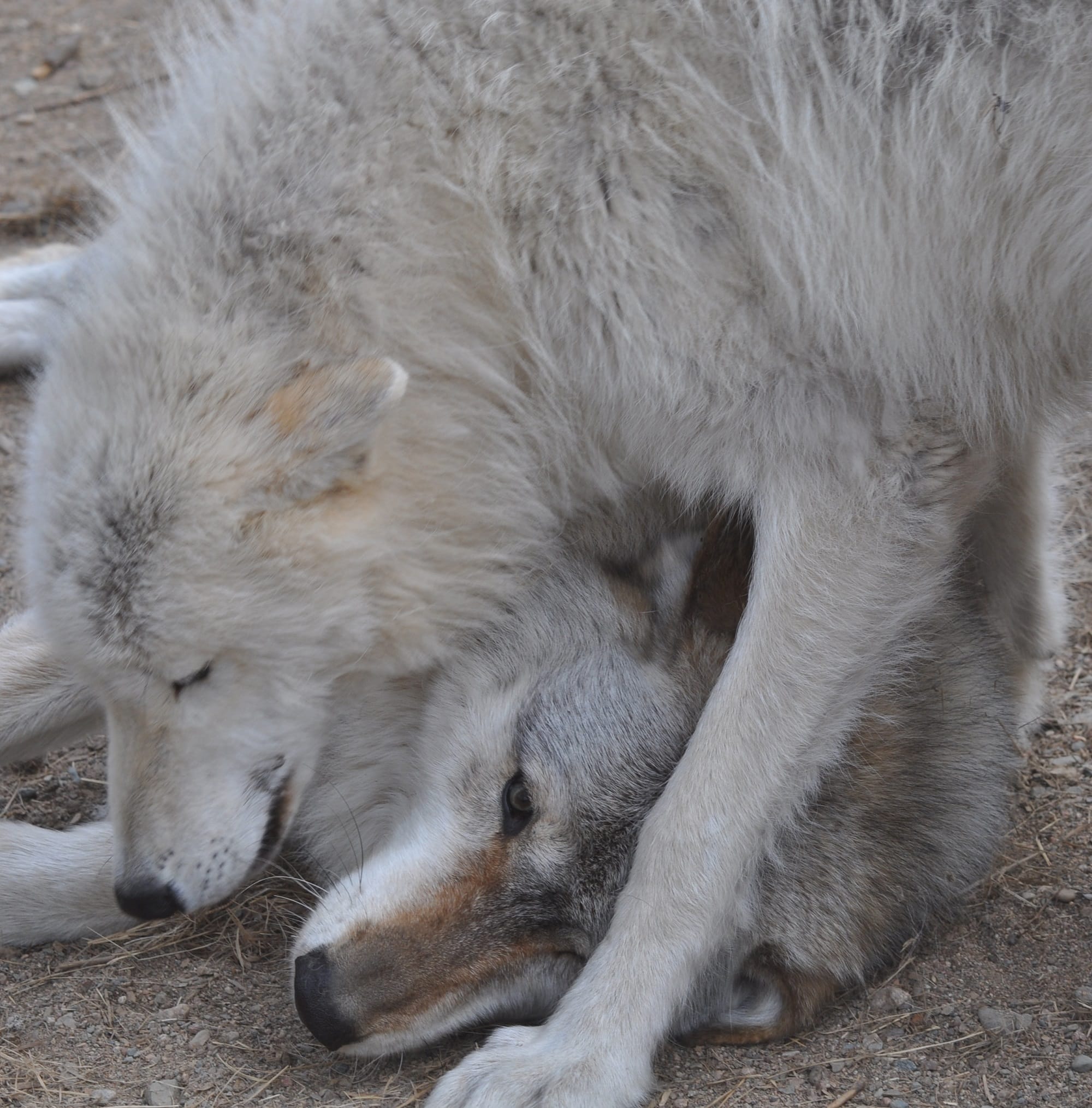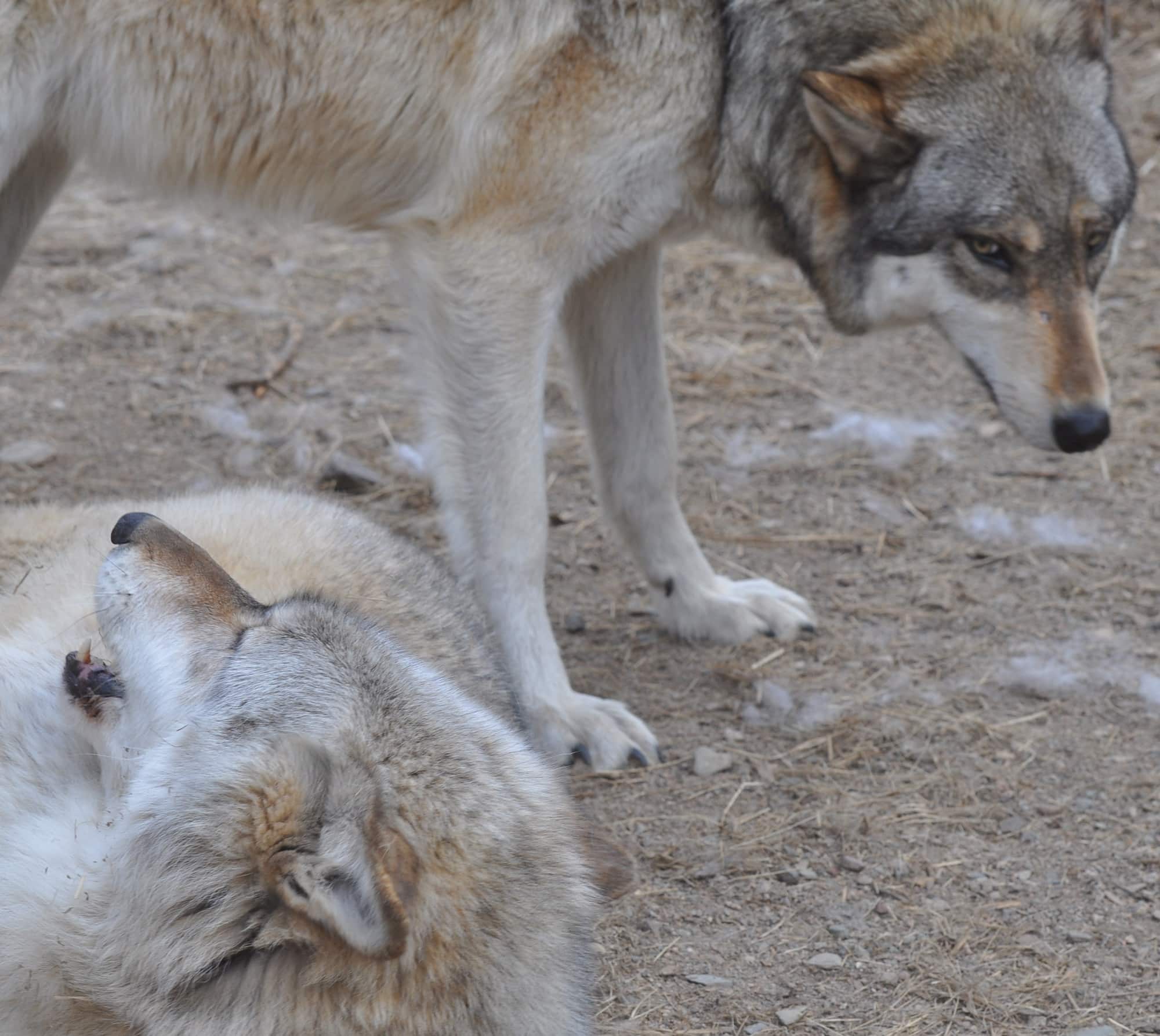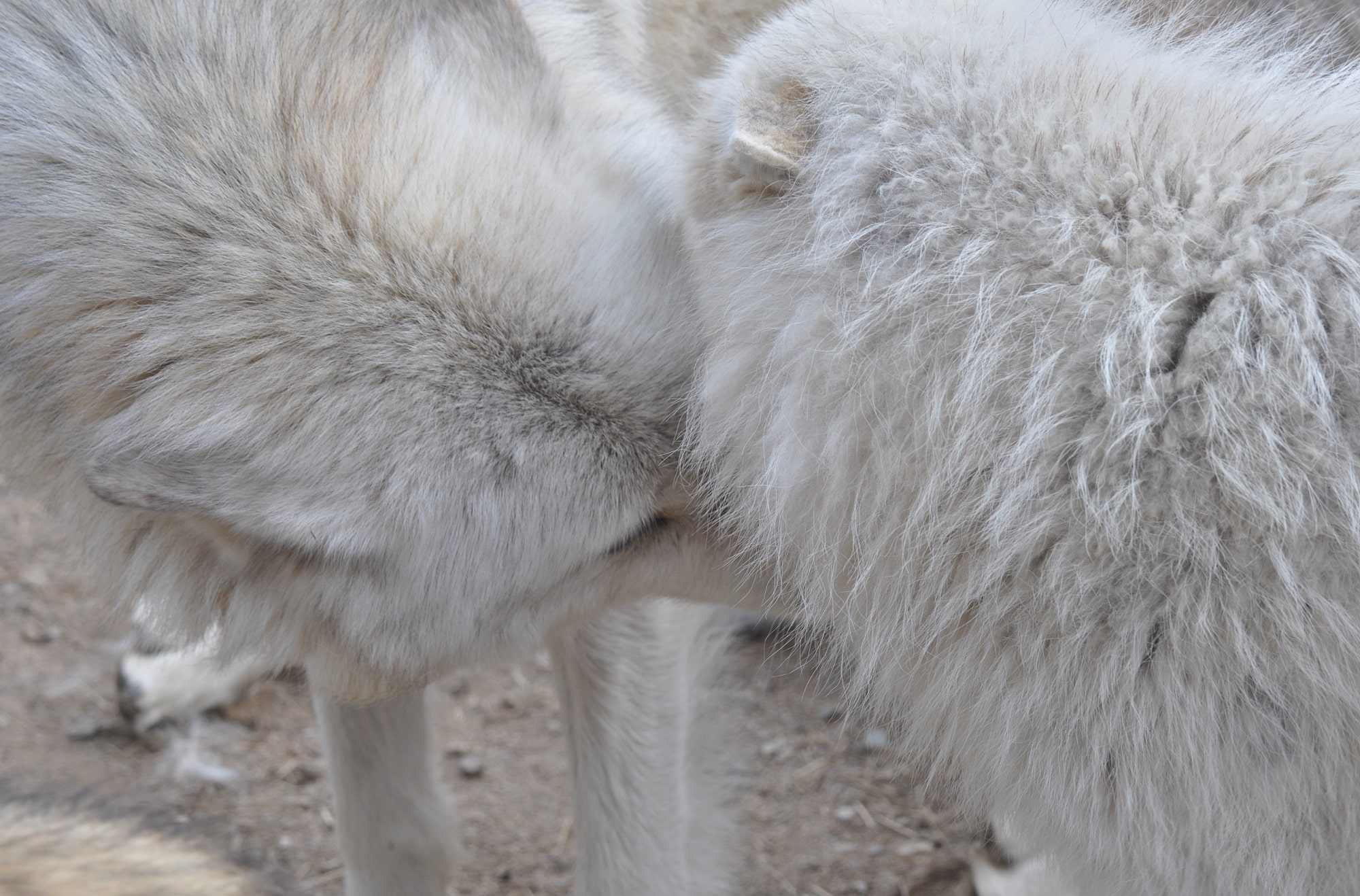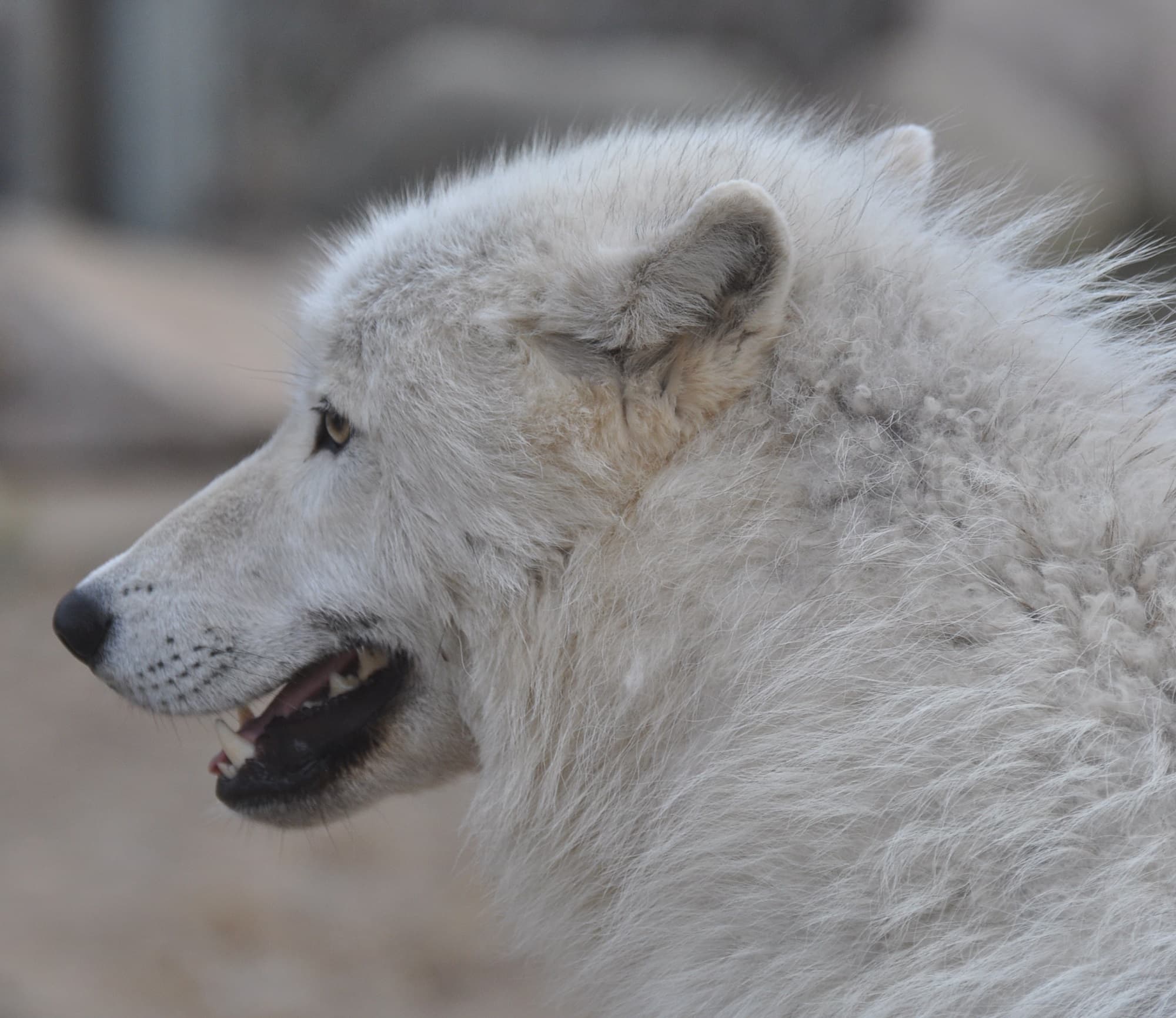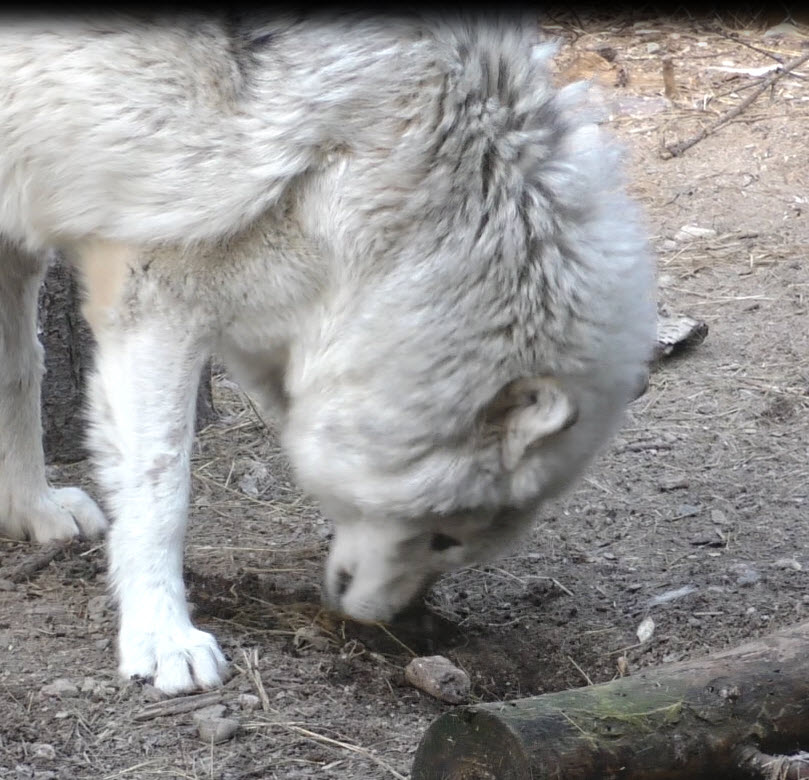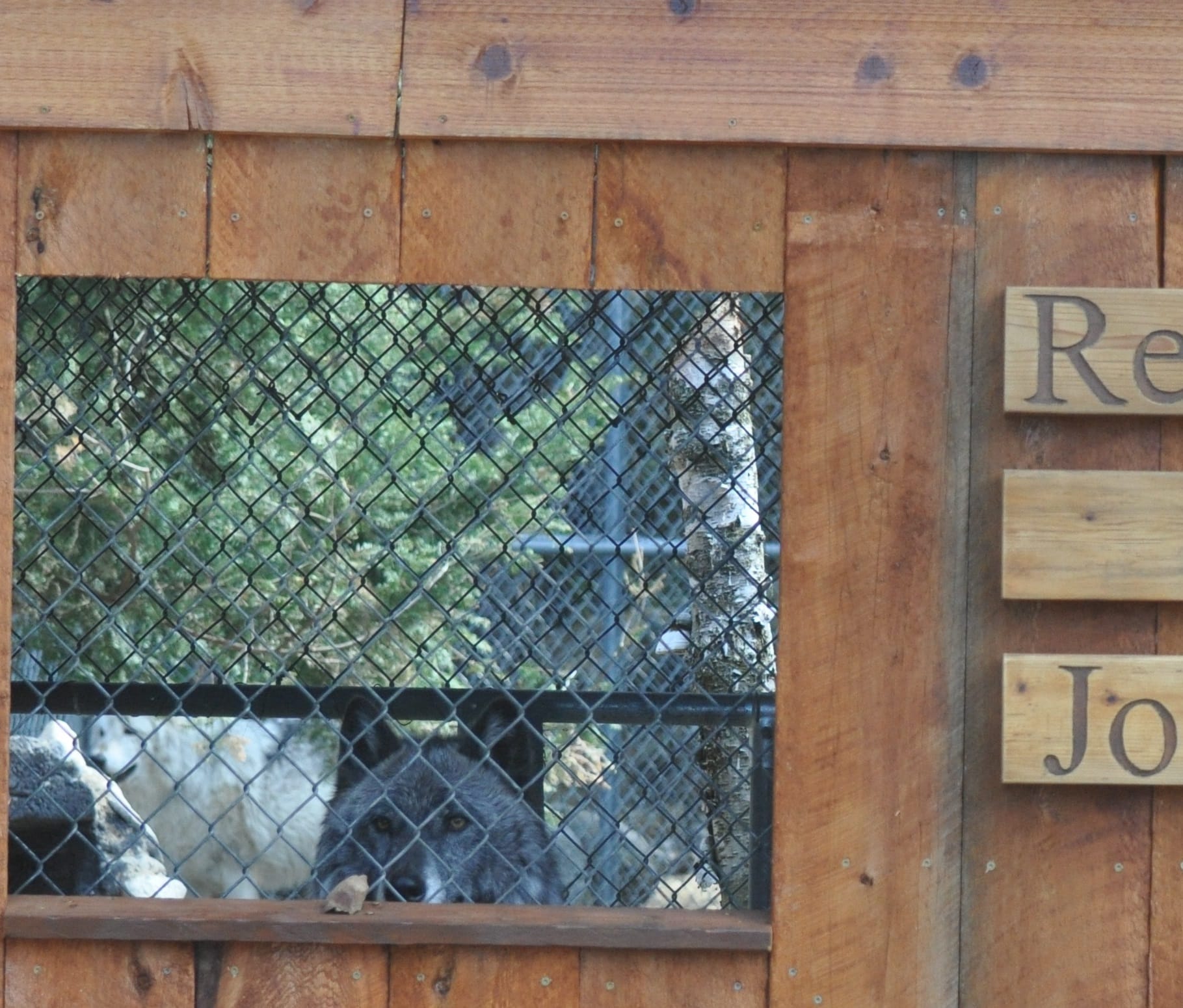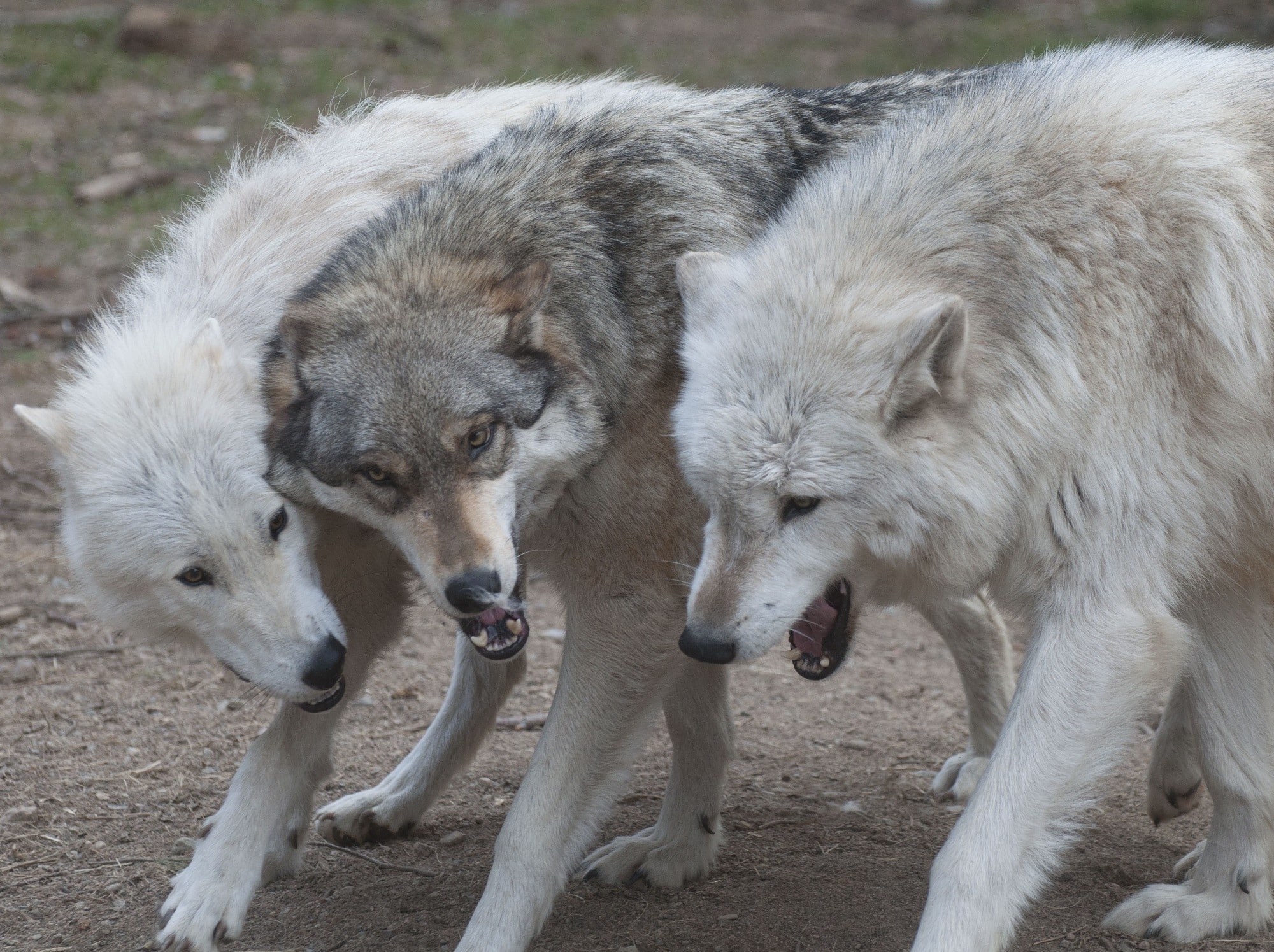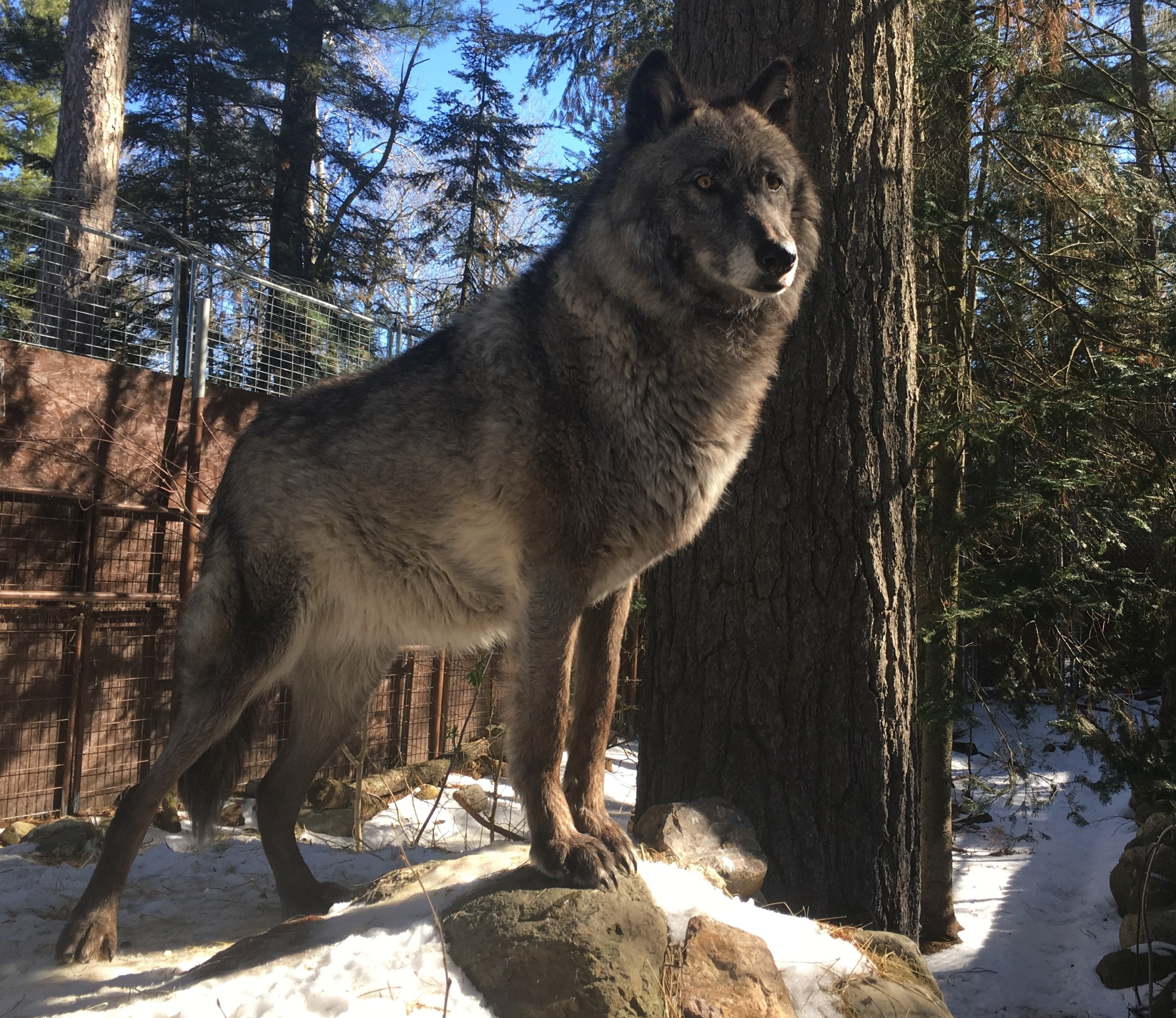While we talk about Boltz watching Aidan and looking for anxiety, we need to remind ourselves that Boltz carries a bit of anxiety himself in the form of an insect phobia. What may have started as a response to a bee sting, has certainly increased to an all out awareness of anything that buzzes near his head. If you have spent time in the great north woods of Minnesota, you quickly realize that there are many things that buzz around our heads. We just started noticing this behavior in the last week and it can certainly influence the reaction of the other wolves. So far, the yearlings haven’t mimicked this behavior, but we know from experience that anxiety of one can influence the others. The bug season might give Aidan a break from Boltz’s testing for a bit, but so will warm weather. Once the temperatures rise, the wolf behavior calms dramatically.
Archives
In this photo, Aidan attempted to enter the pond, but was blocked by Boltz. I was able to capture a bit of this on video for this week’s Youtube. Some of these postures may be too subtle to notice, but with Aidan advancing in age, any posturing is significant. We are still seeing some alliances with the yearlings; Grayson gets preferential treatment from Aidan and Axel seems to be more socially interactive with Denali. Our biggest concern is the focus that Boltz displays towards Aidan. If Aidan is showing any anxiety or signs of weakness, Boltz instantly responds by following, doing a face off or if Aidan is really anxious, Boltz attempts to do a ride-up behavior. Staff protocol is to always greet Aidan as the dominant pack leader first and to watch, but not intervene on rank issues. Intervening and stopping the rank posturing can often give each wolf confidence that they gained some status and make them more intense in future interactions. Our best course of action if tension arises is to provide distractions. Distractions do vary based on the temperature, time since feeding, wind conditions etc., but our list of distractions usually includes ice chunks in the pond, a misting system to keep the wolves cooler, beaver tails, deer legs, bison jerky and miscellaneous hides.
In this week’s photo, we see Aidan resting and showing tolerance for Grayson who comes to greet. These two have a special bond and the tolerance we witness from Aidan is different from his interactions with the other pack members. Not much more to say except that we are fortunate to work with a pack of non-related members who show such strong social bonds.
We just completed a training for the wolf care staff to help us remain attentive to behavioral changes in the upcoming year. We are always cognitive of behavior, but in the upcoming year, we have two circumstances that happen to be occurring simultaneously in the winter/spring of 2018. The first is the yearling pups, Axel and Grayson, will be maturing to full adults at the age of 2, which usually means a bit more testing behavior. The second event is that our pack leader, Aidan, will be reaching 10 years of age. During the training, we discussed our historical yearling behavior that we experienced with the 1989, 1993, 2000, 2004, 2008 and 2012 litters and looked for behavioral cues that are important to document and in some cases may require a modified handling technique. We have less data for which to draw details about pack leader changes since we have only had MacKenzie and Lucas as the dominant pair deposed in 2002 and a pack leader change initiated by a management decision to remove Shadow in 2010. Boltz is definitely on our radar to watch for the obvious eye contact and following behavior that might tell us that his focus is intensifying on Aidan. Fortunately, one can’t focus on much with the pups near by, as soon as one of the wolves looks interested in something, a yearling comes over to see what’s up.
In this week’s photo, we took this close up of Denali and Axel. Denali’s pelage is getting so light as he ages that in a closeup, his head looks like an arctic wolf. As we zoom out, we notice the difference, not to mention the 148 pound body that is more typical of a northwester subspecies than an arctic subspecies.
Grayson seems to mimic Aidan and while that can be a good trait when it comes to leadership qualities, it can also have a downside when it comes to intimidation about being moved off the Exhibit. We have had several occasions to move the Exhibit Pack in the last month. We had some significant hazard trees that needed to be removed before the summer windstorms became an issue, the Vermilion Community College Ethology class moved a lot of cover hay, the VCC fire class moved even more dead trees and branches. The Working for Wolves crew did a significant amount of work cleaning up the Exhibit and thanks to a donation from Anika Hahn, we are putting misting systems in the enclosure to provide some needed relief from the summer heat, especially for the arctic wolves. All of this work requires some type of movement for the pack and one thing about wolves, they don’t seem to like change. Aidan has the hardest issue and we have been watching Grayson show some intimidation as well. We are nearly done with the projects, the Exhibit is ready for summer and we hope to have many days relaxation to relax Grayson’s ear posture.
Whenever a work project is completed, it requires some temporary movement of a group of wolves. When crews are working in the Exhibit Pack, Grizzer and Luna are moved to the back habitat and the Exhibit Pack is ushered into the East Retirement enclosure to give some distance to the work project and Aidan (who has the hardest time with separation). Luna and Grizzer are quite tolerant, waiting for the time they can go back and reclaim their cached objects. This is certainly good stimulation for Grizzer physically as well as mentally. Despite his age, he always seems to know where he cached some meat.
This week’s photo shows Luna looking into the yard from the Pack Holding Area kennel. This project involved building a wall that protects them from rain (a new rain gutter was added) and snow that drifts up against the fence. We left a viewing window as both Luna and Grizzer like to watch the yard. The Working for Wolves projects vary from reduction of fire hazard, removing branches that may cause the wolves to trip, tree planting, removal of straw, fresh wood chips, covering ground wire fence issues, building protective roof’s and barriers around the enclosure and cleaning raven droppings from the rocks. It is amazing the amount of work that is done in a weekend with the dedicated participants that give so willingly of their time, energy and resources to improve the lives of our wolves. Luna is doing well. I recently had a question on Youtube about the possibility of Luna rejoining the Exhibit Pack or was she “forever banned” to retirement. I thought I would share my response here:
Thanks for your question about Luna. Whenever we retire a wolf, there are many circumstances that impact the decision and those decisions are fluid depending upon the dynamics of the pack and the leadership in a pack. There’s no banishment here, only an ongoing process of behavioral interpretation and decisions to make sure we strive for the best care possible for each individual as well as the pack. In the past, we did transition Lakota out of retirement back into the pack, but she was lower ranking and she didn’t have the physical needs that we have to consider with Luna. Luna is getting the care she needs in retirement, including extended periods of body work with her on her back extending her back right leg. This type of care would be less likely in the pack, as you may witness in pack videos, as soon as one wolf is rolled over, the other 4 come to investigate. If you recall from her time in the Exhibit Pack, Luna would become defensive and aggressive with the other wolves around her. This could likely be a defense mechanism because of her medical limitations, but based on how she presents herself to get staff to work on her leg, we believe this is what she needs right now. We have also witnessed some antagonistic behavior from Axel towards Luna. Axel was the pup that received the brunt of Luna’s dominance on the introduction day and when the Exhibit Pack is moved off Exhibit for projects, they go past Luna. Axel usually has a high tail and hackles when he sees her. Needless to say, we are very concerned about Luna’s vulnerability with the pack.
We had a successful Working for Wolves weekend. Thanks to all the participants and wolf care staff for helping to improve the lives of our ambassador wolves. In this week’s photo, the three subspecies of the Exhibit pack are shown. From left to right, Axel, arctic subspecies, Boltz, great plains subspecies and Denali, northwestern subspecies. We were impressed with the wolves tolerance of the work projects. Axel spent a fair amount of time watching the projects and was particularly interested in the Saturday afternoon barbeque.
Luna will not be part of the medical protocol this spring because she received an extensive evaluation and exam last fall after her removal from the Exhibit Pack. While we still think it was the best decision for Luna and the pups to move her to retirement, it’s been our experience that removal from the Exhibit Pack has two components, the physical change of space and the psychological removal from the pack. It’s a challenge, especially for high ranking wolves like Luna to be extremely focused when the adjacent pack activity is heightened. We experienced this in 2002 when Shadow was testing our dominant female, MacKenzie. Once she lost the psychological connection of leading the pack, she relaxed and became more content in retirement. While Luna continues to be “On Watch” for those Exhibit Pack moments, we have been noticing more contentment with life in retirement, especially when sharing den space with Grizzer. For those of you who watch our Youtube channel, the last video showed Luna having some anxiety coming into the Wolf Care Center. We have worked through that anxiety and she is back on track to enter the building and stand on the scale for regular weighing sessions. Her last weight was 111 pounds which is consistent with Boltz. But because of her hip condition, our vet would like her back at 95 pounds. We have adjusted her feeding schedule and expect to see some weight loss as summer progresses. Wolves traditionally look much thinner after they shed their undercoat.

The International Wolf Center uses science-based education to teach and inspire the world about wolves, their ecology, and the wolf-human relationship.

